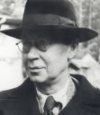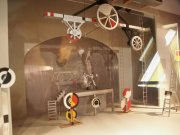
Sergei Prokofiev
The pairing on this disc is remarkably fortuitous. These are the last two of a series of ballets Prokofiev wrote for Diaghilev’s Russian Seasons, written within just a couple of years of one another, in the late 1920s; they both met with success on the Paris stage, and (ironically) were both works which Prokofiev couldn’t really “carry” into the Soviet Union when he re-patriated to Russia. Yet the two works are still more intriguing in their differences.
Prokofiev wrote
Le pas d’acier at a time when the
style mécanique was
tout ce qu’il y a du chic in Paris; and it is a ballet whose scenario expresses some of the fascination which the Communist experiment exercised on Western intellectuals in the 20s (this was before the West much reckoned the cumulative human cost of this radical experiment). On the surface, it seems a ballet which ought to have pleased the music bureaucrats in Moscow; but there can be no pleasing some people.
L’enfant prodigue is of course a stage adaptation of the Biblical parable; in terms of Prokofiev’s subsequent return to Russia, this piece was as leaden a balloon as one might attempt to fly, in an atheistic Communist state.

Serge Diaghilev and Serge Prokofiev
In 1925 Diaghilev (whose company had produced The Buffoon in 1921) approached Prokofiev for (in the composer’s words), “a subject from contemporary life; this is to put it delicately. Crudely translated, it means that I have to write a Bolshevik ballet”.
There is something a bit brash, impersonal, Mayakovskyan in the overall tone; the focus of far the greater part of the action is on the People, the Collective, a general bustle of activity. Even the principals are designated by trade: the Sailor (who will become a Worker) and the Working Girl have one tender duet, immediately before the Scene Change; it is a beautiful number, the more poignant for being the only personal moment in the ballet.
Prokofiev labored assiduously on his scores, even when on tour; a busy schedule notwithstanding, he orchestrated 60 pages of
Le pas d’acier while in America. Often freely spoken, he once replied to an American reporter’s query about the American music scene: “You all ride in automobiles, yet you lag behind in music. I would prefer you rode in horse-drawn carriages but were more up-to-date in music”.
Neither the French
Le pas d’acier nor the English The Steel Step really captures the sense of the noun in the Russian title, which is more like The Steel Leap.
Le pas d’acier is Prokofiev’s Opus 41; his Opus 40 was the enormous and inexorable Symphony No. 2. Even though motoric rhythm is an element characteristic of Prokofiev from the start (cf. the Opus 11 Toccata for piano), and though his music would always be ready for bursts of vigorous energy, there is an earthy right-ness to the proximity of this “iron and steel” Symphony, and this ballet.
Yet they are strikingly distinct, as well; the Symphony almost constantly revels in crunchy harmonies, and is a riot of apparently chaotic textures spanning broad stretches of time; the ballet has a consistent “C-majorish-ness” (domazhornost) to it, sings a succession of melodies, quite a few of which return from time to time, and, of course, the whole consists of a number of relatively compact dance numbers.
The first scene opens with a
tutti unison, which will return as one element in the ebullient polyphony of the Finale. There is something a little tongue-in-cheek, perhaps, in Prokofiev depicting the Commissars with quietly dignified bassoons; but then a cheerful 3/4 tune from the second number (Train with Baggage-Laden Peasants) returns, and against this the Commissar theme is set in firm (and possibly bureaucratic) counterpoint.

Original Set Design for
Le pas d'acierAll the crowd scenes of the ballet are an energetic bustle, with well-shaped melodies; inviting some comparison to (without resting in the shadow of) Petrushka. The Factory is especially effective musical illustration, a chromatic ostinato in bassoons, violas and piano serving as the undercurrent hum of the machinery, while the oboes and English horn play a steady, understated, purposeful melody.
There is a seeming dissonance between alterations associated with
L’enfant prodigue. Although the parable from the Gospel according to St Luke is universally known as the Prodigal Son, the title substitutes for
fils the more general
enfant. Yet the ballet’s scenario fleshes out (so to speak) the episode of the Prodigal’s dissipation, with a very specific (and stageworthy) Seductress, who is absent from Luke’s narrative. We merely remark in passing that these two changes do not seem quite harmonious: changing the title to
L’enfant ‘un-sexes’ the title character, which cannot really be said for the Seductress.
Where
Le pas d’acier is a full-throated Song of the Collective,
L’enfant prodigue is, in sharp contrast, a tender drama in the life of one very human family. That it is a ballet Prokofiev wrote for Diaghilev, is one of music’s supreme ironies. The
Saisons russes in Paris were always about spectacle, brilliance, surface and wit (and, to be sure, bringing glorious Russian artistic talent to the Western audience). The sentimentality of the 19th century was forbidden. But such is the power of the reconciliation scene with which Prokofiev closes
L’enfant prodigue, that many at the premiere shed tears. Said Balanchine, “It was Lifar [Serge Lifar, who created the title role], on his knees, that made the ballet.”
Diaghilev widely praised the score as a masterpiece: “At this moment when we are experiencing such a shortage of real feelings, it seems simply incredible that Prokofiev could have found such musical expressiveness”.
The opening scene (The Departure) is an archetype of Prokofiev’s economy of writing, and of the succinct power of his musical characterization. The vigorous, and unsentimental (‘unfeeling’) opening which depicts the son’s determination to leave; the tender entreaties of his sisters that he stay (solo clarinet in two statements, then solo oboe); these alternate in a brilliantly paced dialogue, yielding to a long-breathed, calm aria senza voce for the father’s appeal to his son. But the son’s mind is made up. Prokofiev’s gift for writing for the stage displays itself here in music which practically choreographs itself.
Having left his family, the son is now free to have a great time with his friends (who will remain his friends as long as he is flush with his inheritance). The second scene opens with a brute, coarse energy which is a cousin to the Knights' Dance in Romeo & Juliet; if it is somewhat thick-skulled music, it serves a fine-gauged dramaturgical purpose, and contrasts perfectly with the music of those who truly love the son.
The entire ballet is a masterful fusion of story with expertly turned music. A particular delight is the agile clarinet trio (two soprano, one bass) of the Burglary scene. The Prodigal awakes from his excesses, and remorse steals upon him with artful variations on the father’s first-scene ‘aria’, and music of his sisters’ pleading.
The emotional crest, though, is of course the Return of the Prodigal (in Prokofiev’s scenario, undisturbed by the displeasure of the older son of the Gospel parable), a miraculous achievement of tender understatement, combined with quiet strength, a scene which seems only briefly to raise its voice above a whisper.

Mikhail Jurowski
Jurowski and the WDR Symphony give these ballets impeccably phrased, vibrant readings here. Thanks to their witness, the world may well wonder why these pieces have lain neglected for so long.
Although Diaghilev had let The Buffoon drop out of his company’s repertory,
Le pas d’acier played for three seasons running.
L’enfant prodigue premiered in May of 1929; but Diaghilev’s health failed rapidly, and he died that August, at age 57.
The Russian Seasons would after re-organize and continue in name. But without Diaghilev, who had felt a paternal interest in fostering Prokofiev (“my second son,” he called Sergei Sergeyevich, after Stravinsky); and because Prokofiev’s at times difficult personality had alienated some key people in the company (notably Balanchine), there was no one after Diaghilev to keep either
Le pas d’acier or
L’enfant going. After December of 1935, when Prokofiev returned to take up permanent residence in Moscow, there was little in his power to keep the ballets in circulation, either.
~ Karl Henning
Please support Good-Music-Guide.com
by purchasing this CD using this link.
